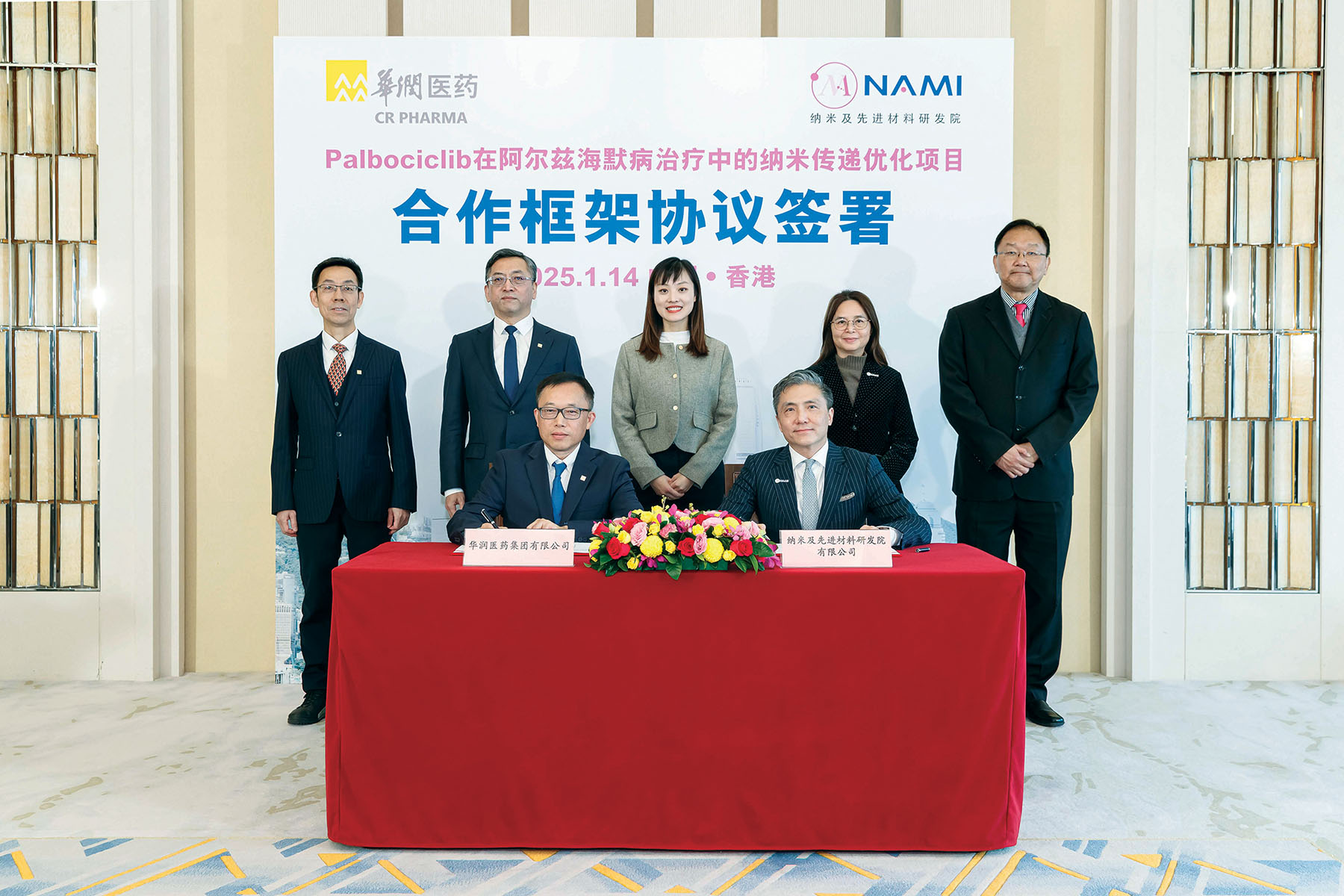
Leveraging its impeccable strength in science and technology and closer ties with the Chinese mainland, Hong Kong is entering a golden decade to cement its status as a global hub for technology and innovation and make a meaningful social impact.
To add a compelling footnote to the city’s tech-powered future, Hong Kong’s Nano and Advanced Materials Institute (NAMI) has joined hands with China Resources Pharmaceutical Group to advance innovation in Alzheimer’s treatment.
In what could be “a prime example of collaboration between Hong Kong’s research and development institutions and Chinese mainland enterprises”, the partnership integrates NAMI’s novel drug delivery system with China Resources Pharmaceutical’s expertise in healthcare innovation, backed by research resources from the University of Hong Kong.
READ MORE: NAMI foresees bright future for innovations in Greater Bay Area
“The cooperation exemplifies the significance of industry-academia-research collaboration in driving transformative healthcare solutions,” said Cheng Shuk-han, chairwoman of NAMI. “It fits in well with the mission of our times set out under the nation’s 14th Five-Year Plan (2021-25) to essentially facilitate the commercialization of technological breakthroughs and foster sustainable development.”
Established in 2006, NAMI is designated by the Innovation and Technology Commission of the Hong Kong Special Administrative Region government as a R&D center for nanotechnology and advanced materials.
Serving as a bridge between research institutions, businesses, and the market, it currently has nearly 5,200 square meters of laboratory space with advanced equipment worth more than HK$300 million ($38.5 million) in Hong Kong Science Park.
Bolstered by 200 R&D professionals, more than half of whom hold doctoral degrees, the institute boasts a strong portfolio of more than 250 patents. Over the past seven years, it has received more than 100 international awards, including the prestigious R&D 100 Awards, the Edison Awards and the Consumer Electronics Show (CES) Innovation Awards.
Meaningful progress
According to Tracy Liu, chief technology officer of NAMI, the partnership will develop a more accessible therapeutic solution by optimizing the nano delivery of Palbociclib — a targeted or biological therapy drug used for breast cancer treatment.
“With NAMI’s expertise in nanotechnology, we are developing an advanced core-shell nanosystem to enhance drug delivery across the blood-brain barrier and absorption rate and improve efficacy while reducing dosage and side effects,” said Andy Fung, CEO of NAMI.
As China’s population ages, Alzheimer’s disease will place great strains on society and test the country’s healthcare system, noted Qiu Kai, vice-president of China Resources Pharmaceutical Group.
Indeed, Alzheimer’s disease and related dementias present one of the greatest challenges for what the United Nations has declared as “the decade of healthy aging”.
There are at least 50 million people worldwide living with Alzheimer’s disease, and this number is projected to hit 152 million by 2050. Some 15.1 million people aged 60 and above in China suffer from dementia, of which nearly 10 million have Alzheimer’s disease, according to the National Health Commission of China in 2023.
“This is where innovation should come in by addressing urgent patient needs and driving meaningful social progress,” Qiu said.
Fung sees a broader story unfolding where “with this generic absorption technique proving to work well, it can be applied to many different medicines across the board and benefit a larger group of people across Greater China and beyond”. As China’s pharmaceutical industry enters a new phase of first-in-class pharmaceutical innovations, from the early stage of generic drugs, this begs the question of where the new technological breakthrough will come from, said Chen Bo, chief scientific officer of China Resources Pharmaceutical Group.
Chen envisages a bigger role that Hong Kong could play, riding high on its extensive access to world-class university resources and cutting-edge research.
“A constellation of local researchers, with the integrated spirits of entrepreneurs and scientists, stand as a major driving force and contributing factor to the vision of building China into a country of innovators,” said Bai Xiaosong, chairman of the board of China Resources Pharmaceutical Group.
Golden age of innovation
Bai said the latest tripartite cooperation also adds flesh to a mega plan that promotes the scientific establishment-oriented original innovation and enterprise-oriented technological innovation, paving the way for translating fundamental research into real-world applications and facilitating successful technology transfer to essentially give a leg up to Hong Kong’s new industrialization ambitions. With the strong backing of the central government and industry-academia-research deep integration, Hong Kong is “embracing the next golden age of scientific research and innovation”, said Lillian Cheong Man-lei, undersecretary for innovation, technology and industry of the Hong Kong SAR.
Cheong said Hong Kong has what it takes to stay closer to and better align with the nation’s push for new quality productive forces, driven by disruptive technologies and seminal scientific breakthroughs. This calls for bold government-led moves and concerted efforts from the finest minds of the industry community, academia and research institutions to power a science and technology innovation center of global significance, Cheong noted. With its innovations mostly having applications in the construction, electronics, energy, environmental and healthcare sectors, Fung said NAMI has a good track record of translating local technology into viable commercial projects for greater social impact.
ALSO READ: NAMI strengthens technology transfer of new materials in GBA
In the healthcare sector, Fung highlighted the breathable and bactericidal N95 nanofiber facemask developed by NAMI. Since the outbreak of the COVID-19 pandemic in 2020, more than 20 million facemasks have been provided to the Hospital Authority of Hong Kong, and the masks are still in use today to safeguard residents’ health.
With an economic and innovative powerhouse across the Guangdong-Hong Kong-Macao Greater Bay Area in the making, spelling enormous opportunities for Hong Kong in terms of talent-sharing, R&D and market access, Fung expects a “good starting point to an encouraging journey of doing good to people’s well-being and the country’s long-lasting development”. In the nation and city’s quest for the next innovation-driven growth engine, NAMI has all the elements needed to make a difference.


